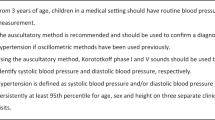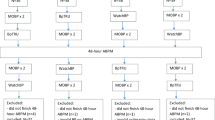Abstract
Mercury sphygmomanometers are being removed from clinical practice in the United States due to environmental concerns about mercury toxicity. Accurate blood pressure measurement is central to high-quality hypertension management. In this study of 106 patients, the BpTRUTM device was compared to nurse blood pressure measurements that complied with all the JNC VII/American Heart Association guidelines in evaluation of a random casual blood pressure. The intermethod difference in systolic blood pressure was +1.8±5.1 mmHg, and for diastolic blood pressure it was 4.8±5.1 mmHg (both P<0.001). For the primary study end point of clinical decision-making, there was 92% (97/106) agreement between the hypertension nurse specialist and the BpTRU™ (kappa 0.8280, 95% confidence interval, 0.721–0.9350). The oscillometric blood pressure measurement with the BpTRU™ is recommended as a replacement for poorly performed auscultatory blood pressure measurement in clinical practice.
This is a preview of subscription content, access via your institution
Access options
Subscribe to this journal
Receive 12 digital issues and online access to articles
$119.00 per year
only $9.92 per issue
Buy this article
- Purchase on Springer Link
- Instant access to full article PDF
Prices may be subject to local taxes which are calculated during checkout



Similar content being viewed by others
References
US Environmental Protection Agency. US Environmental Protection Agency Mercury Study Report to Congress Volume I: Executive Summary. Environmental Protection Agency: Washington, DC, 1997, publication EPA-452/R-97-003.
Bolger PM, Schwetz BA . Mercury and health. N Engl J Med 2002; 347: 1735–1736.
Canzanello VJ, Jensen PL, Schwartz, GL . Are aneroid sphygmomanometers accurate in hospital and clinic settings. Arch Intern Med 2001; 161: 729–731.
Villegas I, Arias IC, Botero A, Escobar A . Evaluation of the technique used by health care workers for taking blood pressure. Hypertension 1995; 26: 1204–1206.
McKay DW et al. Clinical assessment of blood pressure. J Hypertens 1990; 4: 639–645.
Linfors EW et al. Spurious hypertension in the obese patient. Effect of sphygmomanometer cuff size on prevalence of hypertension. Arch Intern Med 1984; 144: 1482–1485.
Cushman WC, Cooper KM, Horne RA, Meydrech EF . Effect of back support and stethoscope head position on seated blood pressure determinations. Am J Hypertens 1990; 3: 240–241.
Silverberg DS, Shemesh E, Iaina A . The unsupported arm: a cause of falsely raised blood pressure readings. BMJ 1977; 2: 1331.
Rose GA, Holland WW, Crowley EA . Lancet. 1964; 1: 296–300.
Wingfield D et al. for the Syst-Eur Investigators. Terminal digit preference and single number preference in the Syst-Eur trial: influence of quality control. Blood Press Monit 2002; 7: 169–177.
Veerman DP, Van Montfrans GA, Wieling W . Effects of cuff inflation on self-recorded blood pressure. Lancet. 1990; 335: 451–453.
Gleichmann SI et al. Educating nurses in blood pressure measurement and hypertension control. J Hypertens 1989; 7 (Suppl 3): S99–S102.
O'Brien E et al. Training and assessment of observers for blood pressure measurement in hypertension control. J Hum Hypertens 1991; 5: 7–10.
Grim CM, Grim CE . A curriculum for the training and certification of blood pressure measurement for health care workers. Can J Cardiol 1995; 11 (Suppl H): H38–H42.
Chobanian AV et al. The seventh report of the Joint National Committee on prevention detection, evaluation and treatment of high blood pressure for the National High Blood Pressure Education Program Coordinating Committee. JAMA 2003; 289: 2560–2572.
O'Brien E . State of the market for devices for blood pressure measurement. Blood Press Monit 2001; 6: 281–286.
Hla KM, Vokaty KA, Feussner JR . Observer error in systolic blood pressure measurement in the elderly. A case for automated recorders. Arch Intern Med 1986; 146: 2373–2375.
Mattu GS, Perry TL, Wright JM . Comparison of the oscillometric blood pressure monitor (BPM-100) with the auscultatory mercury sphygmomanometer. Blood Press Monit 2001; 6: 153–159.
O'Brien E et al. The British Hypertension Society protocol for the evaluation of blood pressure measuring devices. J Hypertens 1993; 11 (Suppl 2): S43–S62.
Hansson L, Zanchetti A . The Hypertension Optimal Treatment Trial (HOT) study: 24-month data on blood pressure and tolerability. Blood Press 1997; 6: 313–317.
O'Neill H, O'Brien E, Stanton A, Hedditch K . The suitability of an automated blood pressure measuring device, the Omron HEM-705CP, in a large multicenter study: the ASCOT study. J Hum Hypertens 2001; 15: S83–S85.
Campo C et al. An approach to improve the diagnosis of isolated office hypertension. J Hypertens 2002; 20 (Suppl 4): S233.
VSM MedTech Manufacturers. Information on File. 2002.
Bailey RH, Knaus VL, Bauer JH . Aneroid sphygmomanometers: an assessment of accuracy at a university hospital and clinics. Arch Intern Med 1991; 151: 1409–1412.
Mion D, Pierin AMG . How accurate are sphygmomanometers? J Hum Hypertens 1998; 12: 245–248.
Ali S, Rouse A . Practice audits: reliability of sphygmomanometers and blood pressure recording bias. J Hum Hypertens 2002; 16: 359–361.
Author information
Authors and Affiliations
Corresponding author
Rights and permissions
About this article
Cite this article
Graves, J., Nash, C., Burger, K. et al. Clinical decision-making in hypertension using an automated (BpTRU™) measurement device. J Hum Hypertens 17, 823–827 (2003). https://doi.org/10.1038/sj.jhh.1001626
Received:
Revised:
Accepted:
Published:
Issue Date:
DOI: https://doi.org/10.1038/sj.jhh.1001626
Keywords
This article is cited by
-
Low Concordance Between Blood Pressures Measured in Periodic Health Examinations and in a Workplace-Based Hypertension Management Program
Phenomics (2022)
-
Clinical Implications of Different Blood Pressure Measurement Techniques
Current Hypertension Reports (2017)
-
Management of hypertension in chronic kidney disease
Nature Reviews Nephrology (2015)
-
Managing Hypertension with Ambulatory Blood Pressure Monitoring
Current Cardiology Reports (2015)
-
MEthods of ASsessing blood pressUre: identifying thReshold and target valuEs (MeasureBP): A Review & Study Protocol
Current Hypertension Reports (2015)



